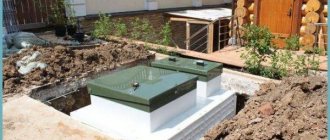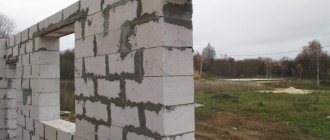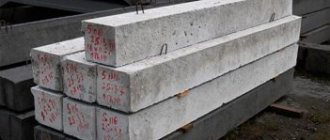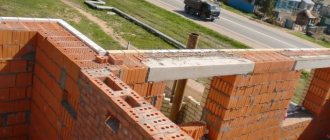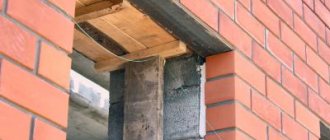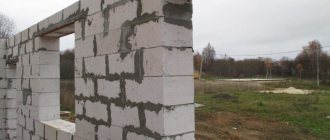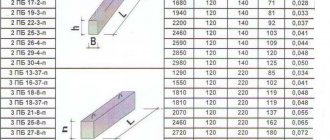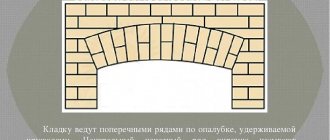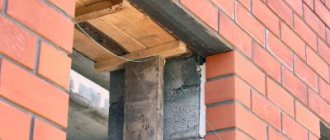It is difficult to imagine a house in which there are no windows or doors. In order to make them, structures are needed to cover the openings.
Reinforced concrete lintels are used for this purpose. Their main function is to transfer the load from the ceiling and brickwork to the side sections of the walls (piers).
The main materials for making jumpers are:
- Reinforced concrete - due to its affordable price and high manufacturability, is widely used in capital construction;
- Steel (I-beam or channel) is used to a limited extent to cover wide openings where windows and doors are subject to heavy loads.
The markings and overall dimensions of reinforced concrete structures are specified by GOST 948-84 . This building standard divides all industrially produced lintels for window and door openings into several basic types:
- PP - slab (width more than 25 cm).
- PB - block (width less than 25 cm).
- PG - L-shaped beams are equipped with a protrusion designed to support floor slabs.
- PF - façade (used for openings in which the masonry protrudes more than 25 cm from the wall surface).
Depending on the size of the working load, all prefabricated lintels are divided into load-bearing and non-load-bearing. The former perceive and transmit to the walls the weight of the ceiling and the upper part of the wall. The latter can only withstand the load from the wall and their own weight.
The load-bearing capacity of reinforced concrete lintels ranges from 100 to 3,700 kg/m. Concrete provides these structures with the necessary compressive strength, and steel reinforcement absorbs tensile forces.
What are lintels over windows, and why are they needed?
If you approach a house under construction and look at the rectangular openings for doors or windows, you will notice that its upper part is made up of special masonry or a beam stretched across it. It is this simple structure that bears the load from the building elements above it. Regardless of the size of the jumpers, they are needed for:
- making the wall structure reliable - the load-bearing surface becomes the support of the entire building, and it cannot be allowed to collapse;
- creating a certain shape of a window recess - the lintels can be a classic horizontal beam, or they can be made in the form of a playful arch;
- bases for the ceiling and continuation of the arrangement of the walls.
The calculation of the opening area occurs long before the start of construction work. Although it is possible to change its dimensions or shape during the construction of a building, it may require significant changes in the design in order to evenly distribute the weight load of the structure.
Reinforced concrete lintels according to GOST 948-2016 – classification
According to GOST 948-2016, jumpers have different markings. They are classified as follows:
- products with the designation PB. These are timber elements having the shape of a parallelepiped with a maximum cross-sectional width of 25 cm;
Lintels are reinforced concrete beams resting on the masonry walls and transferring to them the load of the masonry and floors overlying the opening.
- products marked PP. Externally they resemble a stove. They have an increased width, the minimum value of which exceeds 25 cm;
- crossbars with PG index. A special feature of these reinforced concrete products is a longitudinal groove to facilitate joining with floor slabs;
- façade type lintels, marked with the letters PF. They also have a quarter recess and provide covering of openings from the front of the house.
The standard tables systematize the dimensions, design loads, masses and material consumption of all types of products. Block and slab beams can be manufactured with sloped end planes, as well as side faces, with a slight reduction in the dimensions of the supporting surface.
Options for arranging jumpers
Depending on the installation location, the types of jumpers mounted above the windows differ.
As you know, reinforced concrete floor slabs rest on two sides.
The wall on which the slab rests is load-bearing. And a wall on which the floor slab does not rest is self-supporting. Those. carries itself.
So, window openings located in load-bearing walls are covered with reinforced lintels - 3PB. And in self-supporting walls, 2PB jumpers. The length of the lintel is selected equal to the width of the window opening plus support of at least 250 mm on each side.
Reinforced concrete as the most popular material for lintels
Reinforced concrete parts are combined with each other to create a reliable lintel.
However, to manufacture it, you should know that there are different sizes of reinforced concrete lintels, differing in name:
- PB is a product in the form of a beam, usually no more than 250 mm wide, and the length varies depending on the product labeling and can range from 1 to almost 6 m;
- PP - the product is a tiled surface, and its width already exceeds 250 mm; it is made by fastening several beams;
- PG - products of this marking are produced in the form of beams that have a special groove in their design, called a quarter; PG is used for arranging reliable connections at slabs used for flooring;
- PF is a variant of a reinforced concrete product used on the facade of a building, and “covers” the PG and its recesses.
Some people prefer to make reinforced concrete themselves by constructing formwork, inserting reinforcement parts and filling it all with concrete mixture. However, to create support above window openings, it is recommended to use factory-made lintels. At some factories it is possible to order individual forms for the window opening.
As for the minimum support for lintels, it is at least 250 mm on a brick wall, and for installation on partitions - at least 200 mm.
Materials and tools
Boards for making formwork
To successfully complete the task, you will need the following consumables:
- a set of edged boards of suitable thickness;
- set of metal corners;
- thin reinforcing mesh;
- polyethylene film;
- nails with a wide head;
- self-tapping screws of the required size;
- knitting wire.
Jigsaw for cutting wood
As for the tool, for work you will need to prepare:
- regular hammer;
- electric jigsaw (hacksaw);
- electric drill or screwdriver;
- installation tool (mount);
- “trowel” (trowel);
- small capacity bucket.
How is the opening size calculated?
The size of the opening and the support of the lintels are calculated individually, depending on the type of materials used for the construction of the building, which can only withstand a certain load. Should be considered:
- The weight of the lintel parts, as well as the assembled structure as a whole.
- The weight of the future wall being built above the window recess.
- How exactly will the weight of the wall surface above the opening be distributed (if the masonry is being done in summer, then it is enough to use the weight of 1/3 of the upper part of the wall in the calculations; if it is being laid in winter, then you have to take into account the load exerted by the entire wall).
- The load exerted by floor slabs and beams.
There are also the following formulas for measuring the main parameters of the future jumper:
- load value = specific gravity of the material used * value of the width of the opening * value of the thickness of the masonry in the opening * height of the wall above the lintel;
- strength = resistance of the base material * resistance of a single part * coefficient 1.12.
It is advisable to take the help of professionals to determine the correct size of openings so that during future construction, unforeseen situations such as collapse of materials do not occur.
Methods for making lintels for aerated concrete blocks over windows and doors
Proper reinforcement of aerated concrete buildings is the key to the durability of the structure being built, and also helps prevent the occurrence of cracks and deformations during the entire period of operation.
Reinforced elements are used when it is necessary to increase the strength of gas silicate walls in cottage and private low-rise construction. Lintels for aerated concrete blocks are installed when constructing all window and door openings. This helps distribute the loads from the floors and prevent the appearance of cracks in the window area.
Factory solutions
The technology for using lintels in private housing construction has several fundamental differences from the installation adopted in modern and mass construction using cellular aerated concrete. Currently, several types of jumpers are used, which differ in design features and rules of application .
Ready-made version of reinforced gas silicate lintel according to GOST
Ready-made factory aerated silicate (aerated concrete) lintels are ordinary aerated concrete beams with a rectangular cross-section and an internal frame in the form of reinforcement coated with a special anti-corrosion compound.
Related article: How to make plastic windows close tighter
Arrows on the element indicate the correct direction of installation.
The main advantages are:
- properly reinforced aerated concrete does not crack , does not “float” and does not collapse during long-term use;
- aerated concrete lintels are high-strength, lightweight structures that do not place additional load on the constructed walls and foundation;
- the cellular structure of the aerated concrete lintel is identical to the structure of the building blocks, therefore it does not cause a decrease in thermal efficiency , and as a result there is no need for additional insulation.
Main dimensions of gas silicate jumpers:
- Height - 124 mm;
- Width - 115 mm, 150 mm, 175 mm;
- Length - 1300-3000 mm.
Check on the manufacturers website.
U-block construction
The most popular option is to install precast lintels over windows in walls made of cellular aerated concrete with permanent formwork based on U-shaped elements.
The article provided by the link provides information about the manufactured sizes of these elements and the method of self-production. U-shaped lintels are prefabricated elements . They are easily sawed to the required length using a hacksaw for aerated concrete. A welded reinforcement frame structure is laid in the furrows of the products, after which installation is carried out over a window or doorway using wooden formwork. Reinforced concrete elements are made using heavy mixtures based on concrete and reinforcing rods.
Reinforced concrete lintels
These factory products are concrete beams with reinforcement inside.
In terms of thermal conductivity, concrete is noticeably inferior to gas silicate.
If you plan to insulate the walls of the house with mineral wool, then these beams can be used.
But for walls without insulation, reinforced concrete will act as a cold bridge.
In this case, the aerated concrete lintels proposed in the first option look better.
Features of aerated concrete
Aerated concrete is a fashionable and in-demand building material, used primarily in private housing construction. It belongs to the family of cellular concrete, porous materials with specific parameters. In this group, aerated concrete stands out for its most balanced set of qualities, which make it a leader among all alternative types. The reason for this success was the composition - the components for making aerated concrete are the same as for ordinary, traditional material. The basic components used are Portland cement and sand, to which lime and aluminum powder (gassing agent) are added. When water is added, a chemical reaction begins (aluminum powder and lime in the presence of water), during which active gas evolution is observed. The structure of the material becomes porous, replete with small (2-4 mm) bubbles of carbon dioxide. This is the fundamental difference between aerated concrete and other cellular concrete, which is a mixture of ordinary concrete with porous granules from one or another additional component.
The pores of aerated concrete make it a light and warm material, optimal for building a private house. However, it is not suitable for the construction of multi-storey buildings or industrial structures. This was one of the reasons for the rejection of aerated concrete when it appeared on the market. Builders are accustomed to working with durable and reliable materials and treated aerated concrete as ordinary rigid insulation. Only in the 90s of the last century, when active construction of private houses and cottages began, aerated concrete again became of interest to developers. Its working qualities turned out to be the most balanced and allow for considerable savings during construction and further operation.
Advantages and disadvantages of aerated concrete
The advantages of aerated concrete are:
- light weight, making it possible to reduce the power and size of the foundation and reduce construction costs;
- laying aerated blocks can be done with your own hands, without the participation of lifting equipment;
- low thermal conductivity, providing savings on heating the house;
- smooth and precise block geometry with minimal tolerances, ensuring fine-seam masonry (joint thickness 2-5 mm),
These advantages (except for the geometry of the blocks) are also characteristic of other cellular concrete. However, aerated concrete is superior to them in terms of a combination of parameters. In addition, it is cheaper than other materials, which becomes an important selection criterion for developers.
However, aerated concrete has many disadvantages:
- low strength and load-bearing capacity. This fundamentally distinguishes the material from traditional concrete, which can withstand enormous loads. The pores of aerated concrete collapse under pressure, and the material sags. This is unacceptable when carrying out serious and responsible work, therefore, a restriction on the height of buildings has been introduced for aerated concrete (up to 3 floors);
- hygroscopicity. This quality is common to all types of concrete. However, the porous structure here becomes the main risk factor - moisture is absorbed into the array and begins to accumulate in the pores. When the temperature drops, it freezes and begins to expand, destroying aerated concrete from the inside like a slow explosion;
- inability to resist multidirectional loads (bending and stretching). This is a common disadvantage of concrete, requiring reinforcement of building structures.
Often, the advantages of a material simultaneously become its disadvantages. For example, the low thermal conductivity of aerated concrete, which provides a comfortable microclimate and savings on heating, often becomes the cause of harmful phenomena - the appearance of cold bridges. These are areas whose temperature is lower than the rest of the wall. Cold bridges can be seams that are too thick (hence the importance of precision and care during installation), masonry elements made of ordinary concrete or metal, and other parts with high thermal conductivity. The appearance of such an area is an extremely undesirable event, since condensation begins to settle on it. Aerated concrete gets wet, and the consequences of this process can be very sad.
Support depth and maximum opening length
Depending on the design features, the installation technology, the depth of support of the lintels on aerated concrete blocks, and the basic operating rules may vary.
| Jumper type | Maximum opening length | Support on masonry | Design features |
| Reinforced aerated concrete load-bearing structure | 174 cm | 25 cm | Does not require additional insulation |
| Load-bearing structure made of reinforced concrete using permanent formwork in the form of U-shaped blocks | 300 cm | 25 cm | Does not require additional insulation |
| Monolithic reinforced concrete load-bearing structure | According to beam length | 35 cm | Needs additional insulation |
| Execution by reinforcement | 120 cm | Inserting reinforcement behind the opening by 0.5 m | It is advisable to carry out ordinary reinforcement over openings |
| Monolithic non-load-bearing reinforced concrete structure | 200 cm | 35 cm | Needs additional insulation |
| Non-load-bearing design based on metal corners | 120 cm | 20 cm | Needs to be buried in the masonry |
General technical requirements
The regulatory document regulates the following technical requirements for products:
- the possibility of reinforcing concrete with stressed and unstressed thermally strengthened, as well as hot-rolled reinforcement of various classes;
Brands of serial products consist of two or three groups and fully characterize reinforced concrete lintels: dimensions, load-bearing capacity, cross-section, etc.
- use for the manufacture of heavy concrete mix products with a density of 2.2–2.5 t/m3;
- maximum deviations in product dimensions are no more than 1 centimeter in length and 0.5 cm in height and width;
- the use of concrete marked for frost resistance from F50 to F200 depending on the operating temperature conditions;
- ensuring the required thickness of the protective layer to prevent corrosion of the reinforcement cage.
All products manufactured by reinforced concrete enterprises are tested according to the current GOST for strength, frost resistance, moisture resistance, water absorption, and rigidity. The probability of crack formation under the influence of control loads is also controlled. Tests are carried out after the final hardening of the concrete and its operational strength. Products that have been tested and accepted by the technical control service are given a special mark.
Installation methods
Let's look at how to make a lintel over a window in more detail.
Device using U-blocks
The design is intended to work with floors whose width does not exceed three meters. The use of lightweight elements eliminates the need for a construction crane and other types of special equipment.
Reinforcement is carried out with corrugated metal rods having a strength class of A400-500 with a diameter of 10-16 mm (as determined by calculation):
- when the tray width is less than 120 mm, it is recommended to use two-rod reinforcement;
- when the tray width is greater than 150 mm, it is recommended to use four reinforcing bars, which are connected using tying wire with reinforcing rods in increments of 40-50 mm to obtain a spatially reliable grid.
The support zone of the outer blocks should be 25 cm. To glue the ends of the blocks, standard assembly adhesive for cellular aerated concrete is used. Find out about its choice and consumption from this article.
You can do without special U-shaped trays and build formwork locally from boards and (or) partition aerated concrete blocks. Next, reinforce and fill with concrete. Various methods are discussed in the article about making an armored belt. The design here is similar.
Installation of reinforced jumpers
This option is reliable due to the voluminous steel frame inside the product and is the best basis for finishing decoration.
Dimensions are selected in accordance with the span length and width of the wall blocks. Such an element is used as a beam for one span and is mounted in accordance with the following recommendations:
- lifting the part to the required height and installing it with the arrow pointing up, maintaining a reference depth of 30 cm;
- if necessary, it is allowed to use a pair of lintels in one opening, but the construction of the base of the window opening is carried out exclusively as a monolithic product;
- in the support areas, all elements must be fastened with special adhesive solutions, and the second part is mounted close to the already installed window lintel using a rubber mallet.
The surface is leveled with a plane if necessary. Further work is carried out only after the adhesive mixture has completely dried.
Installation on angles or reinforcing bars
An option widely used in the construction of houses made of cellular concrete. But professionals do not approve of such installation and call it “collective farm” . If you still decide to start a collective farm, then use this design on narrow windows up to 120 cm wide in one-story buildings. And take stronger corners, for example, with a section of 75x75x6 mm.
I would not recommend making a lintel from corners on a wide window, as here.
This design involves the use of metal corners installed with a support depth of 30 cm. Installation work is carried out taking into account the following requirements and rules:
- steel corners must be painted on all sides with special compounds against corrosive changes;
- the minimum supporting length of the metal corner installed on the masonry walls should not be less than 20 cm;
- the corners are fastened together using steel tape, welding or using a standard wire tie;
- metal elements must be recessed into aerated concrete, which will not allow the corners to protrude above the wall surface.
Related article: Polyurethane window frames
Here's another option:
Installation of lintels in stone buildings
The easiest way to decorate the upper part of the opening is to avoid using a lintel, increasing the height of the window right up to the reinforced belt. This is not always possible, because the length of the span imposes its own limitations, especially for load-bearing walls, and besides, it is impossible to bring doors right up to the ceiling. And yet you should know that between the opening and the reinforced crown there must be at least two rows of large-format blocks, or 5-7 rows of bricks, or there should be nothing.
It is easiest to arrange the upper part of the opening in walls on which the ceilings do not rest. If the height of the masonry above the opening does not meet the requirements for self-support, the upper rows are reinforced with reinforcement. Between each brick of the row covering the opening, “clips” are laid - clamps made of 4 mm wire, which protrude above the row of masonry, forming a kind of ears. Under them, longitudinal reinforcement is inserted and tied, one 10 mm rod for every 10 cm of wall thickness, extending 15–20 cm onto the pillars on the sides of the opening.
Strengthening an opening in load-bearing walls made of solid blocks of lightweight concrete is even easier. The masonry above the opening is carried out using a temporary support from below. After this, a groove up to 20 cm deep and 25–30 mm thick is cut in the center of the blocks above the opening. Flat reinforcement is inserted inside - a mesh of 12 mm reinforcement, and then the groove is filled with sand concrete. If it is clear that such strengthening does not meet the strength requirements, use U-shaped trays made of porous concrete in the manner of permanent formwork.
Reinforced concrete lintels are very significant cold bridges. Their use is required only in exceptional cases, when a very wide opening is planned in the load-bearing wall. Such lintels are cast flush with the wall, tamping the panel formwork from the inside, outside and below. The lintels are reinforced in two rows, one 12 mm rod for every 60–80 mm of wall thickness. Depending on the length of the span, another 2–3 reinforcement bars can be added to the bottom row of reinforcement. To prevent heat migration, a pair of EPS slabs with a total thickness of 50–70 mm are installed in the center of the formwork, while the reinforcement is distributed to form protective layers of 40 mm.
When installing jumpers of any type, it is important to be able to properly prepare the “shoulders” on which they rest. As a rule, wood, solid brick or grade 300 cement mortar are used for this.
Tips and tricks
It is important to remember that if the length of the opening does not exceed 1.2 meters, and the height is less than two-thirds of the width, then the most convenient option for the device will be a lintel made of standard blocks without the use of additional fasteners. The blocks must be laid using removable temporary formwork and special glue for cellular aerated concrete. In this case, the side elements are recessed into the wall by at least 115 mm.
Additional reinforcement can be the reinforcement of the rows located above the opening. The optimal cross-section of the reinforcement used is approximately 6-8 mm. The end part extends beyond the boundaries of the opening by 0.5 m on both sides of the masonry. The ends need to be given an L-shape and anchored into the masonry of aerated concrete blocks.
How to draw a plan for floors and coverings
To draw up a floor plan, it is necessary to determine which load-bearing structures will be used - this is also included (prefabricated or monolithic reinforced concrete; reinforced concrete beams, wood or metal, etc.).
The fifth contains notes as necessary.
After the floor slabs are installed over one part of the plan, it is necessary to move on to another and so on, until the floor plan is completely completed.
This kind of work is not that difficult, but it takes time and requires preliminary calculations. The same thing is much faster and easier to do using ready-made lintels for aerated concrete blocks. There are quite a lot of types of structures. They are selected taking into account the nature of the window opening, wall thickness, opening length and other factors.
On average, the thickness of a wall made of aerated blocks is 0.6 meters . Sometimes it is made thinner , but in this case it will be necessary to reinforce not only the lintel, but also install vertical reinforcement. Finished products cannot be used in this case , since vertical and horizontal reinforcement must be connected.
Types of window lintels
A lintel is a rectangular structure made primarily of reinforced concrete. It is mounted above window and door openings, as well as above openings where a door is not provided. This design serves to strengthen the nodes and evenly distribute the load on the wall. There are also jumpers made of wood and metal.
In buildings made of brick, as well as in “monolith-brick” projects, the presence of a lintel is mandatory according to SNiP. In panel structures, the jumper is already in the structure itself.
Video description
Wedge lintel over the door.
Brick lintels made in the shape of an arch
Until the end of the 19th century, any ceilings were made only of brick. This was connected not only with the desire for beauty. These structures support the large weight of the wall lintel using a spacer device that evenly distributes the load from the brick blocks thanks to the fan layout.
Arched lintels were used in the construction of temples in ancient times. In those periods, this was the main method of decorating the upper parts of openings built from brick briquettes.
Brick arch on St. Basil's Cathedral Source publicdomainpictures.net
Since then, these elements have been an obligatory component and an established norm of church architecture. In today's buildings, arched brick lintels are largely designer creations, chosen to decorate facades.
Reinforced concrete lintels
The lintel is needed to strengthen structural units (door openings, window openings, openings without purpose) and to uniformly distribute the load that is created by the wall or ceiling itself. The point is that the load is distributed along the edges of the reinforced concrete lintel. There are many ready-made options for products in sizes, concrete grades and other parameters, but you can also make them yourself.
GOST for jumpers - structure of the standard
The updated version of the interstate standard contains information on the following issues:
- area of product use;
- terminology used;
- product classifications;
- sizes of reinforced concrete lintels for windows and doors;
- main product parameters;
- technical requirements;
- acceptance and control methods;
- marking features;
- organization of transportation and storage.
Let us dwell in detail on the main points of the regulatory document.
Reinforced concrete has found widespread use in modern construction
Making a reinforced concrete lintel with your own hands
To make a jumper you will need a certain tool and material, without which it cannot be made.
- Formwork. These are sheets made of durable material (chipboard, fiberboard), which serve as a kind of form for pouring concrete. Also, the formwork requires spacers to hold the sheets themselves, because simply nailing them to each other will not work - the concrete will squeeze out the formwork and will have to be dismantled. The formwork is set to a level, you can also use a plumb line, and if you have a level, the level will be extremely accurate, which is very important.
- Fittings. It consists of metal rods with stiffening ribs. Necessary to impart rigidity and elasticity to the reinforced concrete lintel. The reinforcement is installed after the formwork is installed, connected to each other, creating a reinforcing mesh. It is advisable to weld the extreme ends of the reinforcement to the wall (or rather, grab it) so that the reinforcement does not float when pouring.
- Concrete. The main component of all reinforced concrete products. Has many brands and classes. For the lintel, concrete of class B15, as well as grade M200, is suitable, but in cases of high-rise construction (from five floors), it is advisable to use grade M250.
If you make concrete yourself, you will need a concrete mixer. If it is not there, then the process of making concrete will be extremely long and inconvenient. In this case, you will need a bath or other structure that will allow you to mix the mixture being prepared.
Concrete consists of sand, water, cement and filler (gravel, crushed stone). Depending on what kind of concrete you want to get, the proportions of ingredients will differ. But there is one caveat: with this manufacturing method, the building should not be higher than two floors and should not be of a dacha type, since the concrete will be ordinary and not vibrated, which is not so good for the structure itself.
After 28 days, the concrete sets and the formwork can be dismantled. This is done using a crowbar or a hammer. Before this period, you should not tear down the formwork because the structure may float a little. It would seem that this is insignificant, but even a loss of half a centimeter can have a very serious impact on the structure, bringing it into an unsatisfactory technical condition.
Also, when checked by technical supervision, this violation may lead to the suspension of work until this malfunction is eliminated. Since, according to SNiP, concrete sets after 28 days, it is recommended to carry out work on concrete after this period, and technical supervision will not see a violation in this. This applies to all buildings and structures, including houses on individual projects (private houses).
Important: the lintel must be flush with the brickwork. It should not stick out in any direction, either on the facade or on the back side.
- If it sticks out, although everything was set according to a level or level, then this means that the formwork was poorly secured and floated. In this case, you need to check the level again (even with a level) and make sure that the jumper has not violated its geometry and has not lost its true, calculated dimensions. If all is well, then the small protrusion can either be hidden with insulation, or beaten off with a jackhammer (alternatively, cut off with a grinder and a concrete disc).
- If the projection of the jumper exceeds the tolerances, then it is better to dismantle such a jumper, otherwise this object may not be accepted until the violations are eliminated. And the dismantling of a lintel in a finished structure, and its dismantling almost immediately after its installation, has varying complexity of repair and restoration work.
Also, lintels can be used in the construction of third-party structures: gazebos, pavilions, tents, stairs (small), garages. The principle of their installation is almost no different from the installation of jumpers in residential buildings, except for the size of the structure. The main use of reinforced concrete products (in particular, lintels) are structures and buildings made of brick, stone, foam blocks, cinder blocks, aerated concrete and other materials with a stone base.
Related article: Tinting apartment windows
Independent masonry of arched structures
To build an ordinary lintel with your own hands, you need to stock up with similar devices as when building walls from ordinary bricks. First, a support device for the material (amplifier) is created; a workpiece is made for this. This is a special form - formwork. For execution you will need simple sheets, you can use 4 - 5 centimeter boards.
It is recommended to first protect wooden products. For these purposes, roofing felt or ordinary thick film (polyethylene) is suitable. The protective material will prevent leakage of the cement mortar and the bottom of the lintel will be level. It is necessary to take into account that each roughness of the workpiece coating is poorly reflected on the outside of the ceiling, which means the appearance of the facade deteriorates.
Lintels for window and door openings: types, sizes, installation features
It is difficult to imagine a house in which there are no windows or doors. In order to make them, structures are needed to cover the openings.
Reinforced concrete lintels are used for this purpose. Their main function is to transfer the load from the ceiling and brickwork to the side sections of the walls (piers).
The main materials for making jumpers are:
- Reinforced concrete - due to its affordable price and high manufacturability, is widely used in capital construction;
- Steel (I-beam or channel) is used to a limited extent to cover wide openings where windows and doors are subject to heavy loads.
The markings and overall dimensions of reinforced concrete structures are specified by GOST 948-84 . This building standard divides all industrially produced lintels for window and door openings into several basic types:
- PP - slab (width more than 25 cm).
- PB - block (width less than 25 cm).
- PG - L-shaped beams are equipped with a protrusion designed to support floor slabs.
- PF - façade (used for openings in which the masonry protrudes more than 25 cm from the wall surface).
Depending on the size of the working load, all prefabricated lintels are divided into load-bearing and non-load-bearing. The former perceive and transmit to the walls the weight of the ceiling and the upper part of the wall. The latter can only withstand the load from the wall and their own weight.
The load-bearing capacity of reinforced concrete lintels ranges from 100 to 3,700 kg/m. Concrete provides these structures with the necessary compressive strength, and steel reinforcement absorbs tensile forces.
Technological characteristics
Industrially manufactured products are checked for compliance with the standard (reinforced concrete lintels GOST 948-84, 13015-2003) for each of the specified parameters:
- frost resistance – F35/F200;
- crack resistance, strength, rigidity;
- concrete strength M200 and higher;
- moisture content of concrete upon delivery – no more than 13%;
- thickness, type, quality of anti-corrosion coating;
- dimensional and quality characteristics of steel for embedded elements, hinges, fittings;
- fire resistance;
- seismic resistance;
- accuracy of geometric parameters.
Standard size range, weight and marking
The GOST dimensions of reinforced concrete lintels are as follows:
- length from 103 to 596 cm;
- height from 12 to 44 cm;
- width from 14 to 38 cm.
The weight of these structures directly depends on the dimensions and can range from 20 kilograms to 2 tons.
Reinforced concrete lintels are mounted on cement mortar. Cutting of these structures for the purpose of adjustment is not permitted. If the wall thickness is large, the opening is covered with several timber lintels, laying them parallel to one another.
Special markings help you understand the wide range of these products. It consists of three groups of alphanumeric symbols separated by a dash.
The first digit indicates the GOST number of the section. It is followed by two letters indicating the type of jumper and two numbers of its length (in decimeters). The second group of numbers contains information about the design load in kN/m. The third group of marking symbols is service and contains data on the degree of concrete density, the presence of mounting loops, the degree of seismic resistance or the class of reinforcement.
For example, let’s decipher the standard designation of a reinforced concrete jumper: 2PB22-3-p:
- 2 — section number (indicated in the GOST table);
- PB – bar lintel;
- 22 – length in decimeters (220 cm);
- 3 – bearing capacity (design load, 3 kN/m);
- p – the product has mounting loops.
To increase the load-bearing capacity of lintels, prestressed reinforcement is used. Such structures can be distinguished by the type of reinforcement indicated at the end of the marking. For example, 5PB21-27-AtV. In this case, AtV is a type of prestressed reinforcement.
Reinforcement of reinforced concrete products
The choice of reinforcement type and rod diameter depends on the type of lintel. According to GOST, for reinforced concrete lintels used in private construction, prestressed reinforcement with a diameter of 6 to 8 mm is used. For floors designed for heavy loads, reinforcement of a larger diameter is used.
For longitudinal reinforcement the following is used:
- heat-strengthened steel type At800 or At600C, hot-rolled steel rod of class A800 or A600 can be used as prestressing reinforcement;
- non-prestressed reinforcement is made of steel A400 or A500, heat-strengthened steel At-IIIC, wire B500 or BP500.
For the manufacture of transverse parts of the frame for reinforced concrete, hot-rolled steels A240, A400, A500, reinforcing wires B-500, BP500 are used. When making bar or slab elements of standard sizes, it is necessary to take into account that with a thickness of 12 cm a flat steel frame is made, and with a thickness of 25 cm a spatial frame is made.
When stressing the reinforcement, it is necessary that the actual deviations in the reinforced concrete do not exceed the values indicated in the table:
Name Geometric parameter Limit deviation, mm
| Deviation from linear size | Length: up to 2500 inclusive over 2500 up to 4000 inclusive over 4000 Width and height: Size that determines the position of: protrusions, recesses and holes of embedded products: in the plane of the lintel from the plane of the lintel | ±6 ±8 ±10 ±5 5 3 |
| Deviation from straightness | Straightness of the front surface profile: up to 2500 long at a given length 1000 long over 2500 to 4000 over the entire length over 4000 long over the entire length | 3 ±3 ±4 |
Before pouring, steel reinforcement rods are laid along the formwork and secured with wire to form a strong reinforcing mesh. The cells of the resulting frame should be 20-50 mm, this is the optimal indicator for ensuring the required strength.
Approximate prices and selection features
The most popular length of lintels used in residential construction is from 1.2 to 2.2 meters. The estimated cost of slab-type structures (width 38 cm) ranges from 600 to 4000 rubles. Bar lintels of similar length can be purchased at prices ranging from 250 to 1,700 rubles per piece, depending on the selected width and height.
When choosing the type of lintel above the windows, do not forget that slab lintels can only be installed in a non-load-bearing wall (on which the floor slabs do not rest). Bars can be installed in any type of enclosing structures (non-load-bearing and non-load-bearing).
The width of all manufactured reinforced concrete lintels is a multiple of the width of the masonry. Thanks to this, they are easy to choose for any object. For example, for partitions with a thickness of half a brick (12 cm) and one brick (25 cm), there are more than three dozen standard sizes of products ranging from 1 to 6 meters in length on the market. For thicker walls (1.5 bricks or more), the industry produces slab lintels.
For installation in non-load-bearing walls, it is more profitable to use slab lintels, because their width is equal to the width of the wall. In this case, you will have to use several pieces of timber beams.
When purchasing, you must take into account the support of the lintels on the wall - the main criterion for the reliability of the ceiling. If the area of the supporting part turns out to be less than the standard, then destruction of the material on which this structure rests may occur. To restore the load-bearing capacity of the pier, you will have to do the labor-intensive dismantling of the lintel, dismantling and re-laying the destroyed area.
In general, for a load-bearing brick or aerated concrete wall, the depth of embedding (support) of the lintel should be at least 25 cm. For a self-supporting wall, the size of its supporting part can be reduced to 12 cm. The lintel above the doorway should extend its ends onto the wall no less than 20 cm.
The height of the lintel is selected based on the calculated load on the opening. The developer does not need to perform complex strength calculations, since the full specification of these structures, indicating the dimensions, is contained in the design documentation. During independent construction, you should not engage in amateur activities with the selection of jumpers. It is better to contact the designers for advice.
The technology for installing lintels over openings is determined by the type of wall (load-bearing or non-load-bearing). In the first case, a powerful reinforced concrete beam is placed under the slab. Two other smaller sections are placed in the middle of the wall. The outer one goes down one row of bricks, forming a quarter.
In a non-load-bearing wall, the lintels are the same size. The outer one is lowered by a quarter, and the rest are placed at the same level.
Strengthening openings in frame buildings
When installing jumpers of any type, it is important to be able to properly prepare the shoulders on which they rest. As a rule, wood, solid brick or grade 300 cement mortar are used for this.
If the opening exceeds the width of five times the distance between the posts, the verticals closest to it should be double. The internal pair is connected to each other by a horizontal jumper, and the external one is the same, but higher by half the height of the opening. The space between two horizontal crossbars is filled with a diagonal stiffening mesh based on the principle of floor trusses.
The linear dimensions of the jumper are also important. Its width is determined by the thickness of the wall, its height by the required load-bearing capacity. The length of the lintel corresponds to the width of the opening plus twice the depth: from 10 cm for brick walls and up to 30 cm for loose porous blocks.
In the lower part of the opening along the plane of each wall, two pieces of corner steel with dimensions of at least 50x50x4.5 mm must be laid. They need to be inserted into the wall at least 50 mm on each side. Vertical side corner covers are inserted between the lower and upper corners. They are usually chosen to be equivalent in size to the top frame.
Reinforced concrete lintels are products made of concrete and reinforcing steel, which are fully used in the construction of buildings of any type. Their direct purpose is to cover openings in walls (for example, for doorways or windows) to transfer the weight of the structure onto them. Additionally, they can be used in the construction of any object where it is possible to use them (fences, fences, frames, etc.).
The installation of reinforced concrete lintels is carried out strictly after masonry using a water level to ensure correct installation. Each type of jumper has its own installation system:

